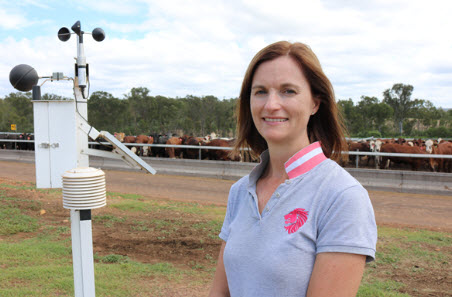New go-to guide on automatic weather stations

Australian lot feeders now have access to a practical guide on selecting, installing and maintaining on-site automatic weather stations to help manage the impacts of heat load on cattle.
Commissioned by MLA, the Review of Automatic Weather Stations for cattle feedlots was produced by Brisbane-based consulting company Katestone Environmental.
What is it?
Katestone provides the Cattle Heat Load Toolbox (CHLT), an internet-based service which produces targeted forecasts of heat load for feedlot sites in Australia.
The review of automatic weather stations is designed as a reference document to help lot feeders meet the requirements of calculating heat load index (HLI), including information on instrument requirements, site selection, operation, maintenance and calibration.
It also includes a summary of a range of automatic weather stations that meet the requirements for calculating HLI and are also suitable for uploading to Katestone’s HLDN (Heat Load Data Network), detailing the automatic weather station instruments, indicative cost and supplier contact information that can be used by a feedlot operator to purchase its own automatic weather station.
Why is it needed?
MLA Feedlot Project Manager, Dr Joe McMeniman, said the current requirement of the National Feedlot Accreditation Scheme (NFAS) for excessive heat load management is that feedlots maintain records of daily monitoring activities and actions taken where indicated, over the summer period.
“Daily monitoring activities could be as simple as recording weather forecast or on-site weather station data, but it could also utilise the excessive heat load forecast from the Cattle Heat Load Toolbox as an early warning system. It could also include monitoring feed intake depression and panting scores,” Dr McMeniman said.
Katestone Managing Director, Christine Killip, said the review contained a good practice guide to ensure automatic weather stations were recording accurate and reliable data, including black globe temperature, relative humidity and wind speed.
“A feedlot’s automatic weather station needs to be in a location that’s representative of where the animals are. Obviously, you can’t put it in a pen with the cattle, but you want a location that’s close to the pens,” Christine said.
“It should be installed on ground that’s natural earth, not on a slab of concrete or asphalt, as that will change the environmental conditions.
“It also needs to be kept away from trees, in an open area that’s not shaded. The black globe temperature needs to be in the sun at all times, otherwise it’s not going to be representative of the conditions.”
How is it monitored?
Maintaining and calibrating automatic weather stations is also critical. Calibration is the practice of checking an instrument against another of known accuracy, or with a process of known properties.
Christine said calibration is essential to provide accurate data but is one of the most commonly neglected tasks.
“Automatic weather stations should be professionally serviced once a year – try to do that in winter when conditions aren’t critical,” she said.
“Between services, it’s a good idea to routinely check your weather station to make sure all sensors are clean, free of debris and insects and in good working condition.
Christine strongly recommends checking the weather station against other references. If feedlots have other weather stations on-site, compare the measurements or look at measurements from the closest Bureau of Meteorology weather station.
“The other thing that I would recommend to do is look at the data. When looking at a number on a screen, it’s quite difficult to understand whether it’s correct but if you look at a time series of the information you can generally see if something’s going wrong.
“For example, if the solar panel or battery aren’t working correctly the weather station instruments will quite often go to zero overnight. If you look at a time series, you’ll see that the measurements drop to zero overnight, generally at the same time each day.”
More information
To access a copy of the Review of Automatic Weather Stations for cattle feedlots, please register and visit Katestone’s Cattle Heat Load Toolbox.



